

This article is from the January-February 2004 issue of the Confederate Philatelist. Posted with the permission of the journal editor.
Confederate blockade uses are highly desirable specialty items among Confederate postal history collectors. About 400 such covers exist with the majority of these coming from Wilmington, North Carolina, Charleston, South Carolina, or Brownsville, Texas, as "incoming blockade usage." Roughly 30% of recorded blockade uses are known to be "outgoing."
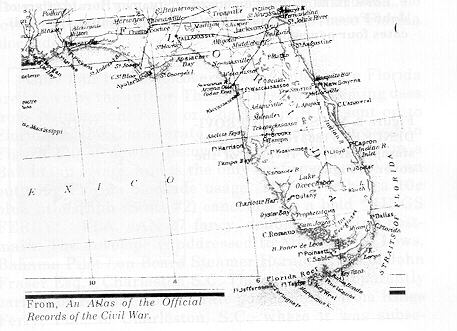 |
Florida, with its 472 miles of Atlantic coastline and 674 miles of Gulf coastline, would seem ideal for blockade running. The prewar commerce in cotton with England and cattle shipments to Cuba generated Florida considerable cash income. The federal government quickly realized after the start of hostilities that this trade had to be halted. The Union East Gulf Blockading Squadron and the South Atlantic Blockading Squadron were initiated in late 1861 for this purpose, and were quite effective in eliminating most Florida overseas trade. Blockade running, however, became quite a profitable venture for a few native Floridians familiar with the changing tides and narrow and shallow inlets connecting with inland waterways. More than 1,000 blockade runs were made from Mosquito Inlet near New Smyrna on the Atlantic coast alone. Numerous others were made along the shallow Gulf coast. The few that were captured by the Union blockade became prizes of war; 299 such cases were adjudicated during the war in the United States District Court at Key West. The top prize was $173,955.77 for the steamer Magnolia with its cargo of cotton. Despite a flourishing activity in blockade running in Florida, no covers or mention of mail is known from these Florida blockade runs.
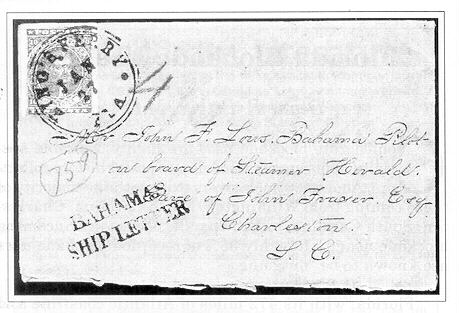 |
| Figure 1 -- KINGS FERRY * FLA * JAN 27 (1863) black double outer rim fancy postmark ties a 10c blue lithograph to an "outgoing blockade" cover. Cover is addressed to "Mr. John F. Lows, Bahama Pilot on board of Steamer Herald. / Care of John Fraser, Esq. / Charleston / S.C." The manuscript "4" indicates four pence postage due. |
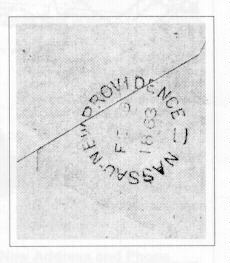 |
Figure 2 -- NASSAU - NEW PROVIDENCE FE 9 1863 receiving handstamp mark on reverse of the cover in Figure 1. | |
Only four blockade covers from Confederate Florida are known by the author. Three of these are incoming uses from Wilmington, N.C., or Charleston, S.C., sent on to Florida by the Confederate postal system. The cover in Figure 1 is a newly discovered cover obtained from a Bahamian estate, and is the only confirmed usage of an outgoing Florida blockade usage. This cover has a 10c blue lithograph (Scott #2) cancelled by a bold *KINGS FERRY* / FLA. JAN 27 fancy, double-outer-ring postmark. The envelope is addressed to Mr. John S. Lows, Bahama Pilot / on Board Steamer Herald / Care of John Fraser Esq. / Charleston S.C. The cover was apparently carried by regular Confederate postal routes from Kings Ferry, Fla., to Charleston, S.C., where it was subsequently sent by a blockade runner to the Bahamas. It was likely carried on the Calypso, which departed Charleston on February 5, 1863. A blue manuscript "4" (pence due) rate was placed as a ship fee and a black BAHAMAS SHIP LETTER straight-line handstamp was added. At the final destination, a "NASSAU-NEW PROVIDENCE FE 9 1863" receiving handstamp was placed on the reverse (Figure 2). Whether the cover was ever received by Mr. Lows is unclear. There is a pink crayon "Unclaimed" manuscript marking across the cover face. This cover has received a 2003 PF certificate stating this to be "A genuine usage blockade cover." This King's Ferry cover is the third recorded Confederate usage from this small town, known at that time mainly for its lumber mill.
Steve Walske has been researching Confederate blockade uses and does have a record of another outgoing blockade cover from Jacksonville, Florida, which item was reported in Sloanes Column, August 11, 1945. It was postmarked at Jacksonville, on February 5, 1862, with stamps missing, and sent via Bahamas on 14 March 1862, and ultimately to Reading, Vermont. The envelope has a circled "5 due" with a New York steamship postmark. The addressee was unclear. This cover has not been seen by the author and may well represent a second outgoing Florida blockade usage. How it got from Jacksonville to the Bahamas is unclear. The "5 due" rate must have represented the incoming ship rate to the New York port of entry from the Bahamas. There was no apparent blockade ship rate or ship-letter handstamp or manuscript notation on the cover to confirm outgoing blockade usage to the Bahamas.
 |
| Figure 3 -- WILMINGTON N.C. DEC 18 postmark and manuscript "12" rate on "incoming Blockade" cover from Glasgow, Scotland with usage to Tallahassee, Florida / South America. |
The cover in Figure 3 has an enclosed letter datelined Glasgow, Scotland, October 22, 1863. It is addressed toTallahassee, Florida, "South America." The writer apparently considered the Confederacy "South America." This cover entered at Wilmington and received a December 18 postmark there along with a manuscript (due) " 12" rate to reflect the two-cent ship fee and the regular ten-cent Confederate rate for delivery to Tallahassee, Florida. The enclosed letter relates English sympathies for the Confederacy and notes of reports in the British press of reinforcements for General Brag (sic) and that Charleston is "still yours." This cover may well have been carried on the Heroine, which entered Wilmington on December 18, 1863.
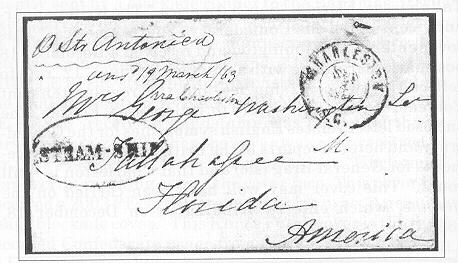 |
| Figure 4 -- CHARLESTON S.C. SEP 4 1863 double circle postmark with oval STEAM-SHIP handstamp and manuscript 12 cent rate on an "incoming blockade" cover from London with use to Tallahassee, Florida / America. Envelope is docketed "Per Str Antonica." |
The cover in Figure 4 is a cover from England sent "per Steamer Antonica" to Tallahassee, Florida, America. It entered at Charleston and received a September 4, 1863, double circle postmark and an oval Steamship handstamp and a manuscript (due) "12" rate in pencil.
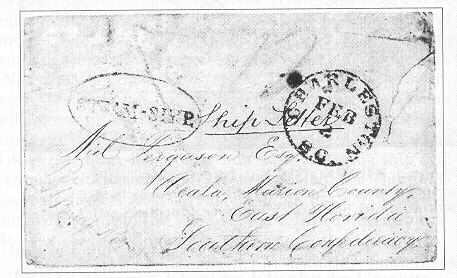 |
| Figure 5 -- CHARLESTON S.C. FEB 2 postmark with oval STEAM-SHIP handstamp and manuscript 12 cent rate on an "incoming blockade" cover to "Ocala, Marion County / East Florida / Southern Confederacy." |
A cover sent from England sent "Per Princess Royal" and addressed to Ocala, Marion County, East Florida, "Southern Confederacy," is illustrated in Figure 5. It entered the Confederacy at Charleston and received a February 2 (1863) postmark, an oval Steam-Ship handstamp, and a manuscript "12" rating in pencil. According to Walske, this cover is a companion to another cover addressed to Richmond leaving London on December 10, 1862, and carried on the Princess Royal, which arrived in Charleston and was also postmarked February 2 thus substantiating the 1863 date. The use of the term "Southern Confederacy" is unusual as is the use of the term "South America" on the cover in Figure 3.
The author would appreciate correspondence with anyone having knowledge of or a copy of the Jacksonville, Florida, outgoing blockade usage recorded in the Sloanes Column of August 11, 1945.
References:

 Return to Top of Page
Return to Top of Page 
